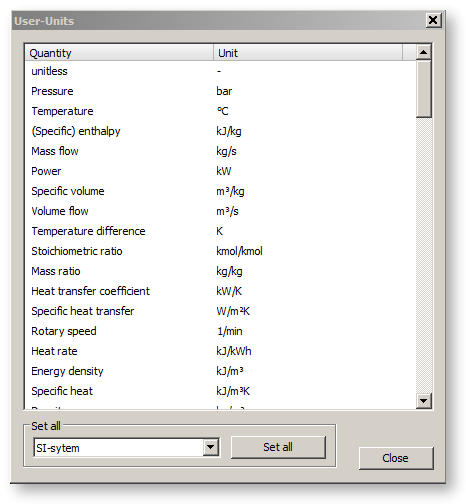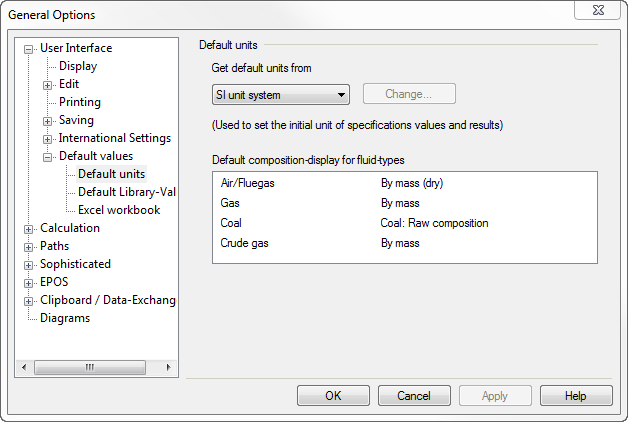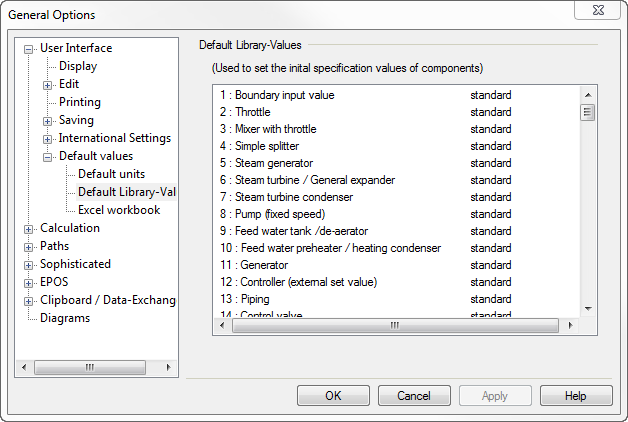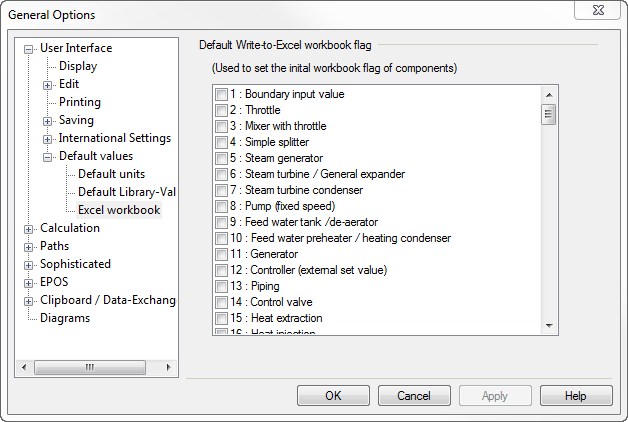

This section defines which defaults are to be valid for

Both the units (e.g. °C or °F) for the physical quantities (e.g. temperature) and the display type for the composition (e.g. mass fractions or molar fractions) are set under the item “Default units“.
The settings described here serve to define which unit system is to be used when inserting new components and lines. It does not have to be identical with the unit system used for the display. The setting for the display is located under the “International Settings”.
The following options are available in the drop-down list under “Get default units from“:
If you select ”User defined system”, the button ”Change” will be enabled and you can edit the user-defined unit system.
The user-defined unit system enables you to separately specify the unit that is to be used when inserting new objects for each physical quantity (pressure, temperature, mass flow, …):

To do so, please select the line with the quantity whose unit you want to change and click on the unit to open the drop-down list where the units available for this physical quantity are displayed for selection.
In the field “Set all“ you can reset the unit to the unit corresponding to the unit system set in the drop-down list simultaneously for all quantities.
In practice, certain quantities are often related to “standard conditions“, with different standards being applied depending on the context.
In former versions of Ebsilon, it was possible to specify air mass flows in the units “Nm³/s“ and ”Nm³/h“, based on a “unit conversion” with fixed factors. These factors were defined in the Model Options by specifying the reference condition. The conversion, however, was only correct for dry air then.
As this procedure had been rather error-prone and did not enable the use of different standards within one model (which had actually become necessary in practice), the option to specify quantities related to standard conditions as measured values was created. Here it is possible to define in which way the standardization is to be affected.
See:
The error-prone units have been removed from the unit table, so that they can no longer be used.
When loading old models, they are automatically converted to corresponding default units (e.g. ”kg/s“ for mass flows). As internally default units are used for the calculation anyway, the results will not change.

Air / flue gas Mass fractions / By mol / By mass (dry) / By mol (dry)
Gas By mass / By mol
Coal Raw composition / Water and ash free composition / Water free composition / Ash free composition
Crude gas By mass / By mol
This table serves to define which data record from the default values is to be used when inserting a component into the model. Here both the data records internally contained in Ebsilon and the user-specific data records defined by the user can be selected (see chapter:
[Data Transfer and Results Display > Component Standard Values Database > Standard Values]) .

By default, the entry with the name “standard“ is used for all components when inserting. If you want another data record to be used when inserting a component, just double-click in the line of the corresponding component type.
The dialog “Load Library Values” will open, where the drop-down list under “Name“ is already expanded and the desired entry can be selected.

This section refers to the old default Excel interface where all data of a component are written into a separate sheet of an Excel file dedicated to the model and are read from it respectively. Whether a component is to be included into this Excel file can be individually specified for each component in the sheet “Basic Properties” of the Component Properties window.
In the list “Default Write-to-Excel workbook flag“ you can make a default setting for each component type. For all components selected here, the inclusion into the Excel file is already activated when inserting the component.
